Welcome to our comprehensive guide on caring for and maintaining Hinoki Cypress Bonsai (Chamaecyparis obtusa). This exquisite tree species requires proper attention to ensure its health and beauty. In this article, we will provide you with valuable information on the care and maintenance practices that will help your Hinoki Cypress Bonsai thrive.
Key Takeaways:
- Proper care and maintenance are essential for the health of your Hinoki Cypress Bonsai.
- Ensure your bonsai receives full sun during the growing season and sufficient light in winter.
- Protect your bonsai from hard frost, icy winds, and intense sun exposure.
- Keep the soil moist but avoid overwatering, and use a lime-free water source.
- Fertilize your bonsai every four weeks using solid organic fertilizer or a liquid fertilizer.
Appearance of the Hinoki Cypress Bonsai
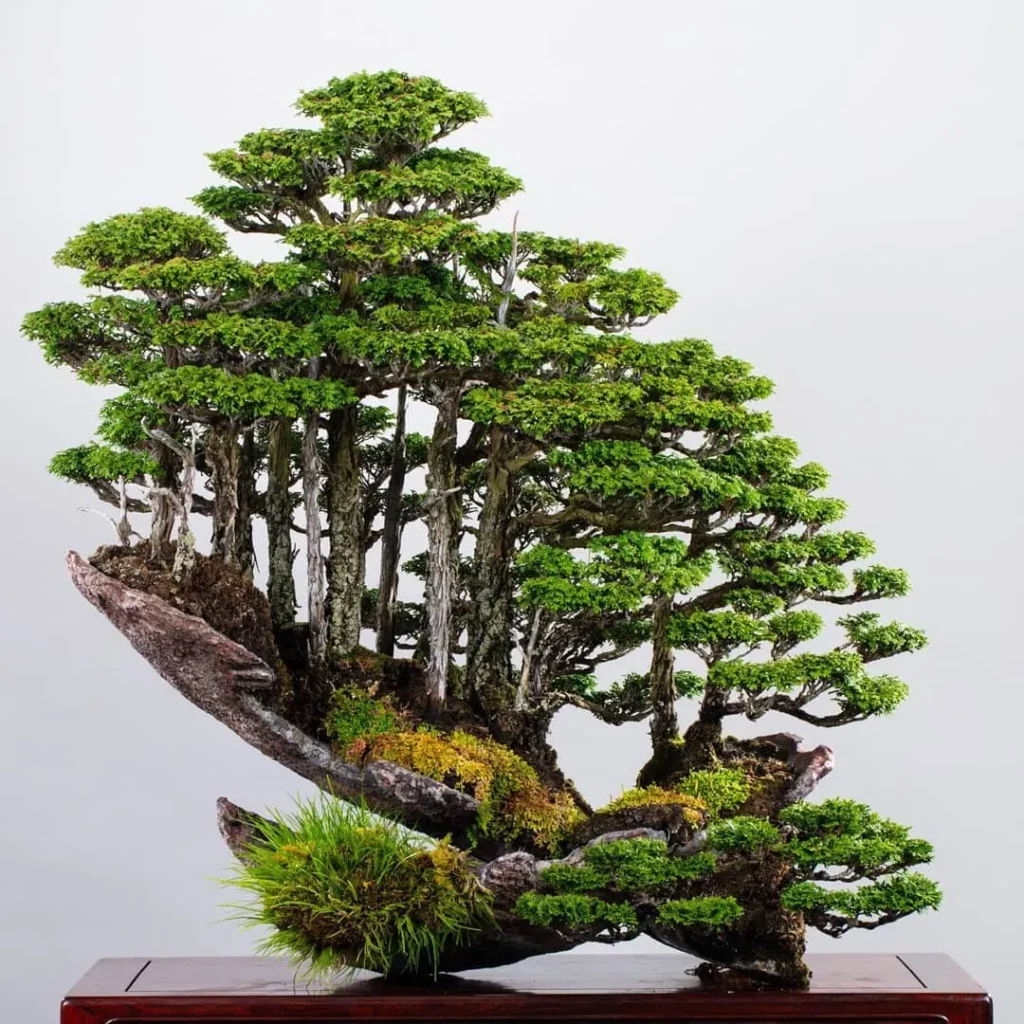
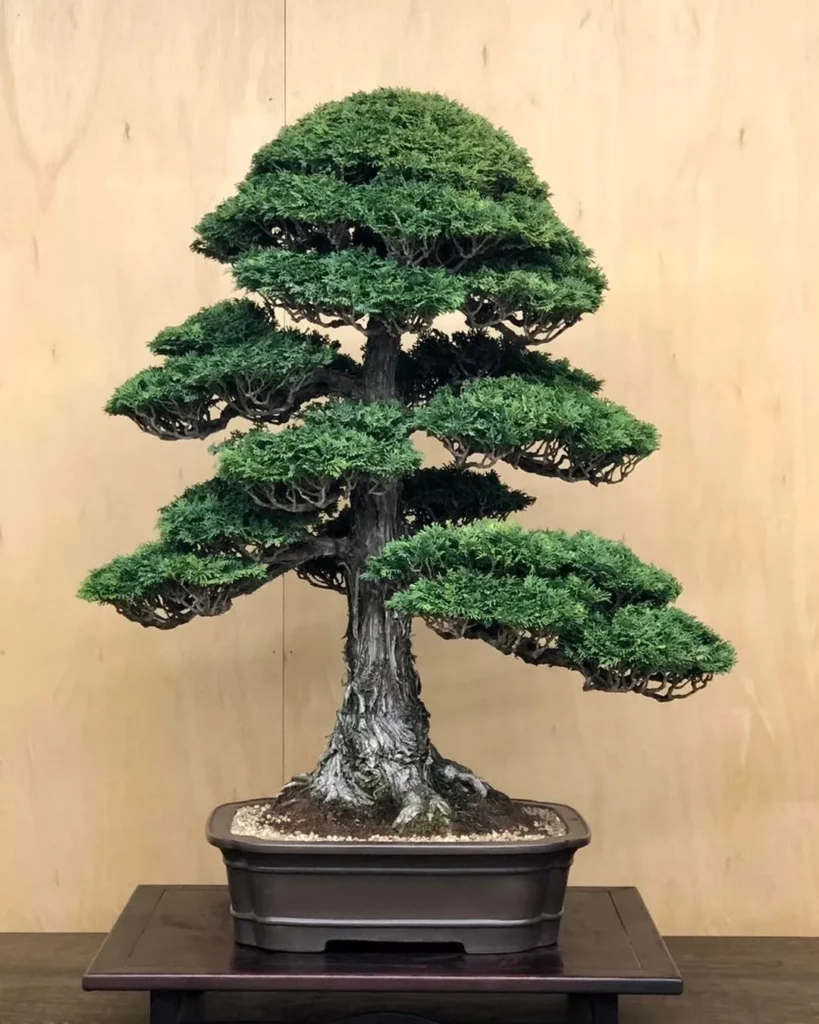
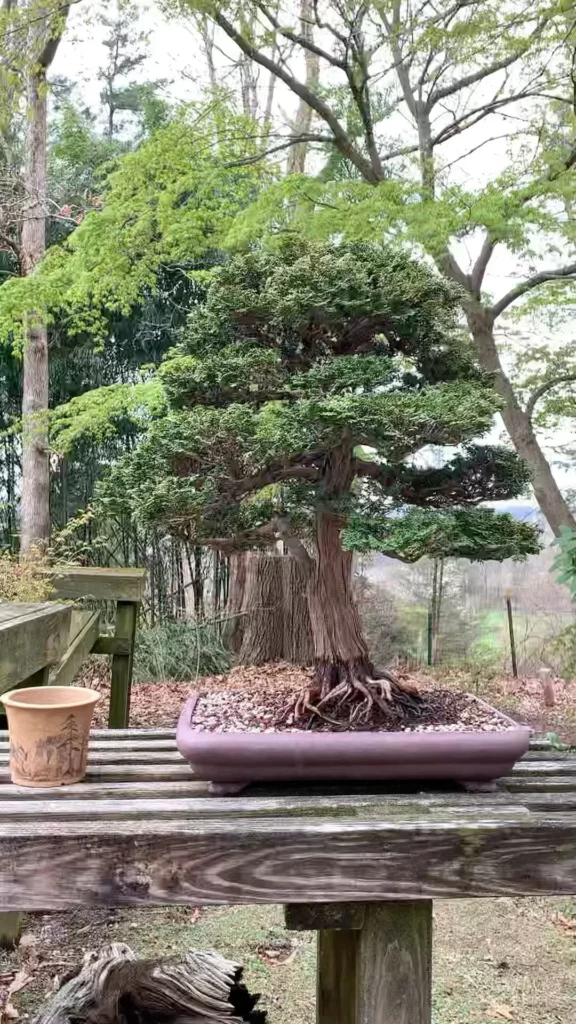
The Hinoki Cypress Bonsai is a visually striking tree species that showcases its beauty through its unique appearance. These bonsai trees can grow up to 40 meters tall, with a trunk diameter of 3 meters, making them an impressive addition to any collection. The scale-like leaves of the Hinoki Cypress Bonsai are dark green and form flat fanning fronds, creating a lush and vibrant aesthetic. The reddish-brown bark of this bonsai species peels in attractive strips, adding further visual interest to its overall appearance.
It is worth noting that there are also dwarf cultivars of the Hinoki Cypress Bonsai available. Varieties such as Yatsubusa, Chirimen, and Sekka have been specifically bred to have smaller and more compact foliage, making them ideal for bonsai cultivation. These dwarf cultivars retain the same captivating appearance as their larger counterparts while allowing for greater versatility in styling and placement.
Whether you choose a standard or dwarf cultivar, the Hinoki Cypress Bonsai is sure to catch the eye with its striking appearance and unique charm. Its scale-like leaves, peeling bark, and overall grace make it a prized addition to any bonsai collection.
Light Requirements for the Hinoki Cypress Bonsai
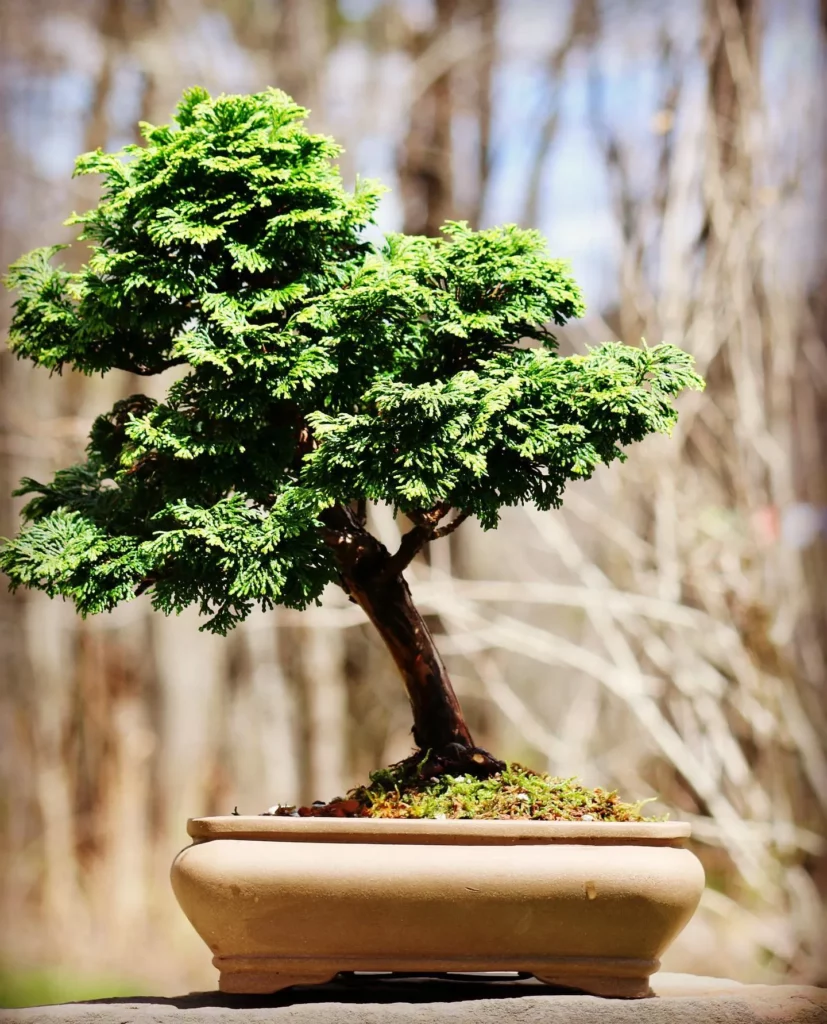
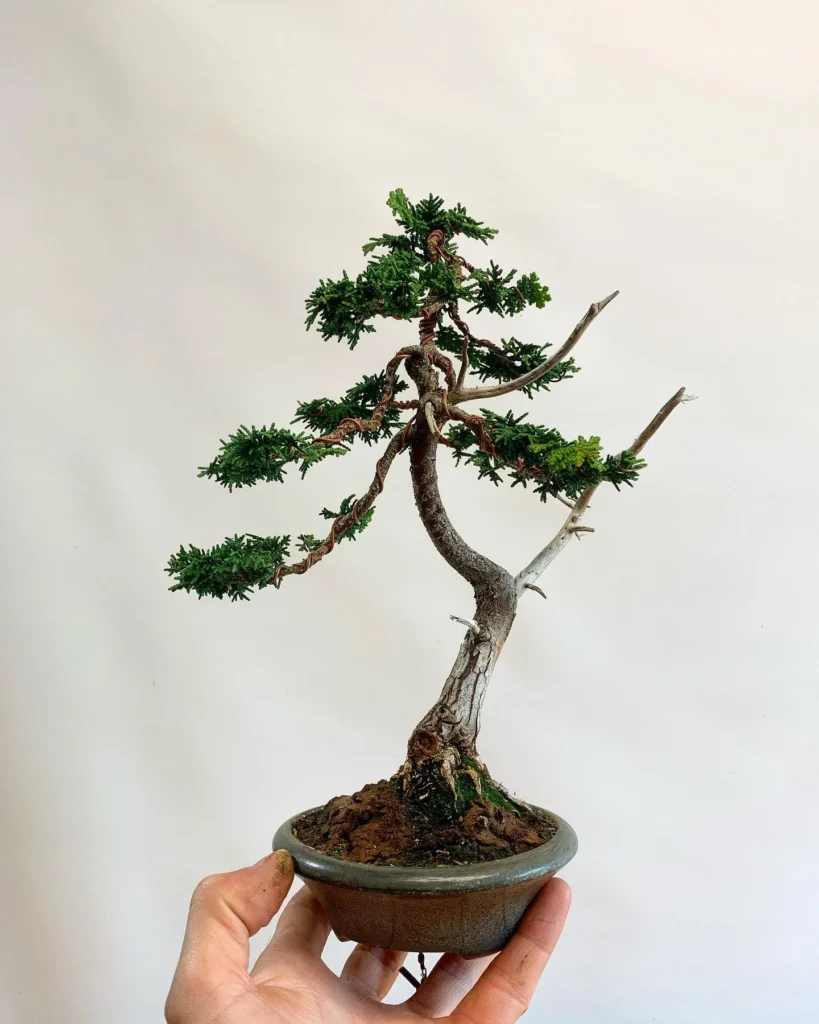
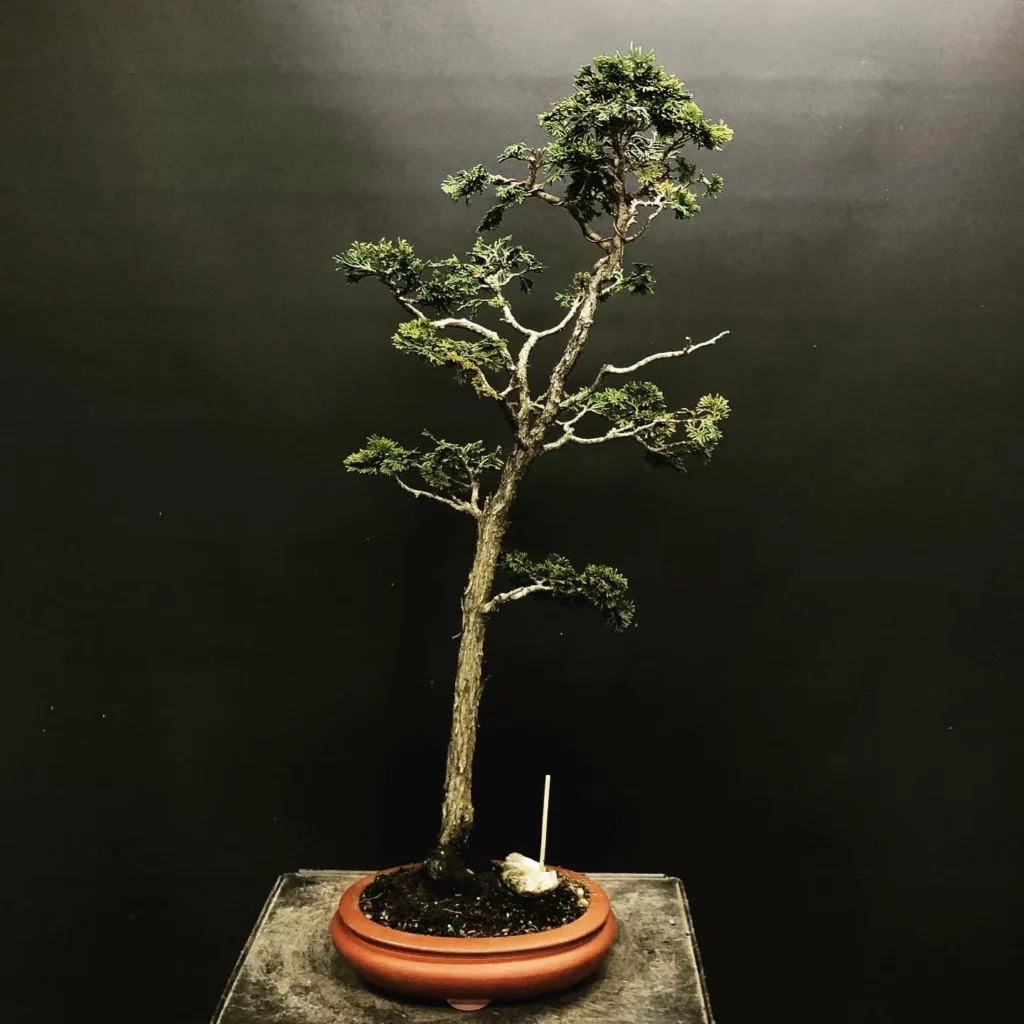
Proper lighting is essential for the healthy growth of your Hinoki Cypress Bonsai. This bonsai tree thrives in full sun during the growing season, so it’s important to place it in a location where it can receive maximum sunlight. However, if you live in a hot climate, providing some shade during the hottest part of the day can help protect the tree from intense sun exposure. The Hinoki Cypress Bonsai also requires sufficient light in winter, so be sure to place it in a well-lit area during the colder months.
When determining the right spot for your bonsai, consider the direction of sunlight in your garden or indoor space. Ideally, your Hinoki Cypress Bonsai should receive direct sunlight for at least 6 hours a day. If you are growing your bonsai indoors, place it near a south-facing window to ensure it gets enough light.
Keep in mind that light requirements may vary depending on the specific cultivar of Hinoki Cypress Bonsai you have. Some dwarf cultivars may require slightly less light than the larger varieties. It’s always a good idea to research the specific light needs of your particular bonsai tree to ensure optimal growth and health.
Watering the Hinoki Cypress Bonsai
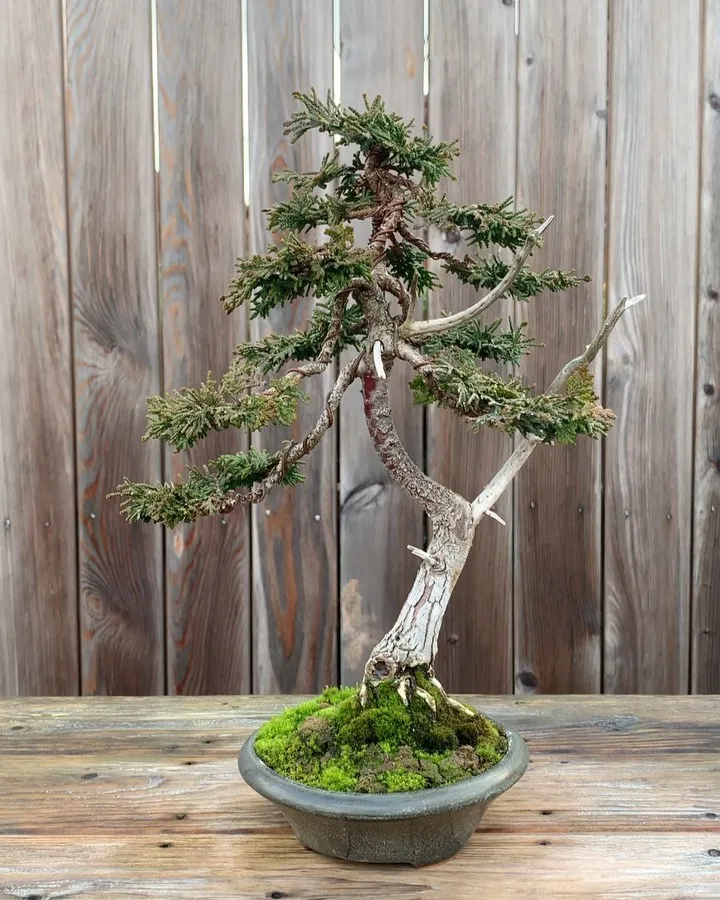
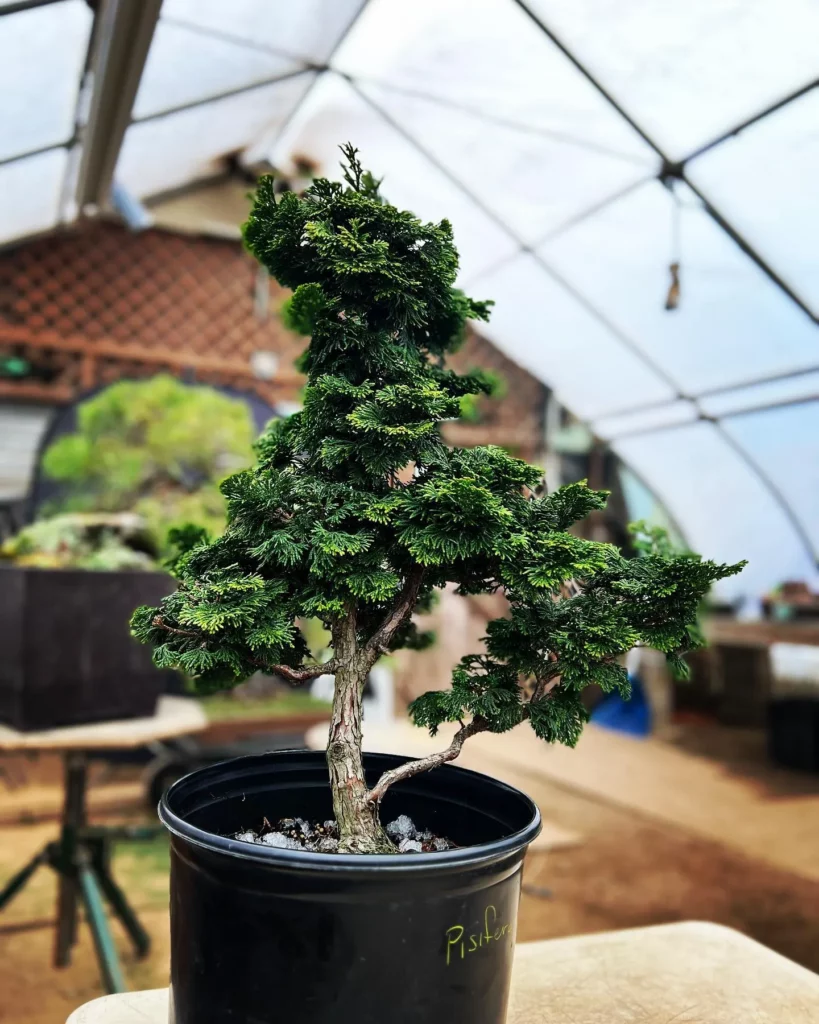
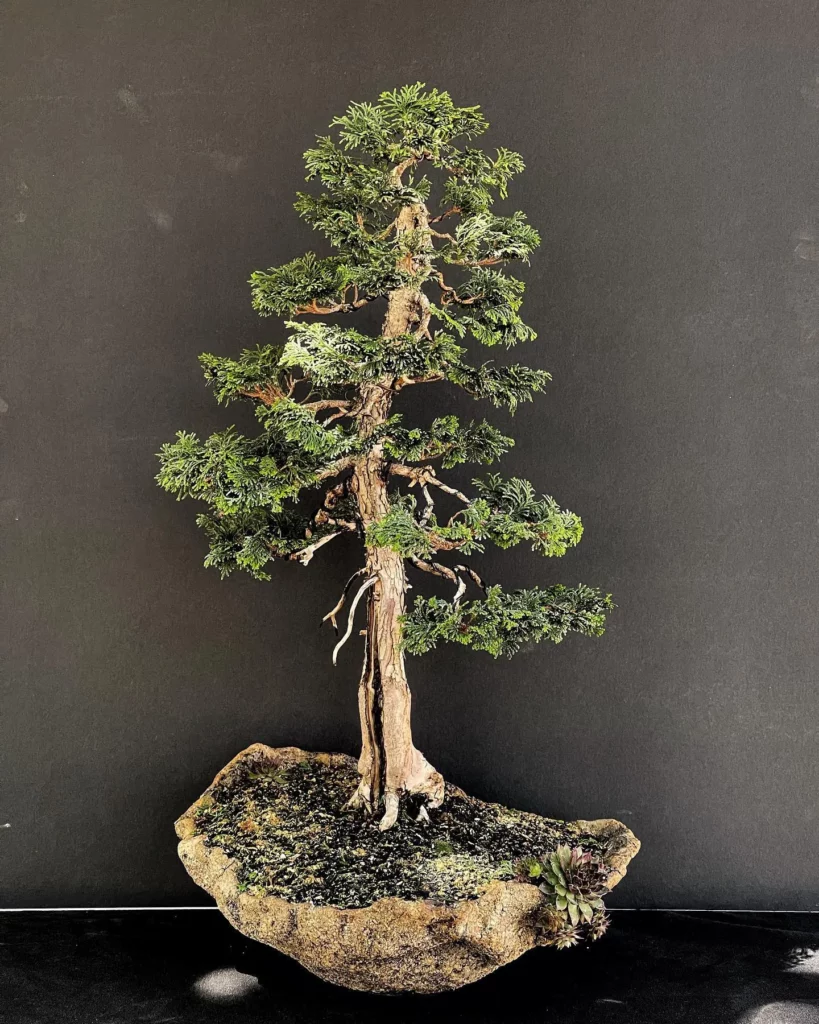
Proper watering is essential for the health and vitality of your Hinoki Cypress Bonsai. It is important to monitor the moisture levels of the soil and water the bonsai as soon as the soil becomes dry. However, be careful not to overwater the tree, as excessive moisture can lead to root rot and other issues.
When watering your Hinoki Cypress Bonsai, make sure to use lime-free water to prevent any mineral buildup in the soil. This can be achieved by collecting rainwater or using filtered water. Avoid using tap water, as it often contains high levels of chlorine and other chemicals that can harm the bonsai.
During the winter months, when the bonsai is in its dormant phase, you should reduce the frequency of watering. However, it is important to ensure that the rootball never dries out completely. Remember that the foliage of the Hinoki Cypress Bonsai appreciates humidity, so if you live in a dry climate or during periods of hot, dry winds, consider misting the foliage to provide additional moisture.
Watering Tips for the Hinoki Cypress Bonsai:
- Water the bonsai as soon as the soil becomes dry.
- Avoid overwatering to prevent root rot.
- Use lime-free water to prevent mineral buildup.
- Reduce watering frequency during winter, but never let the rootball dry out completely.
- Mist the foliage in dry climates or during hot, dry winds to provide additional humidity.
Fertilizing the Hinoki Cypress Bonsai
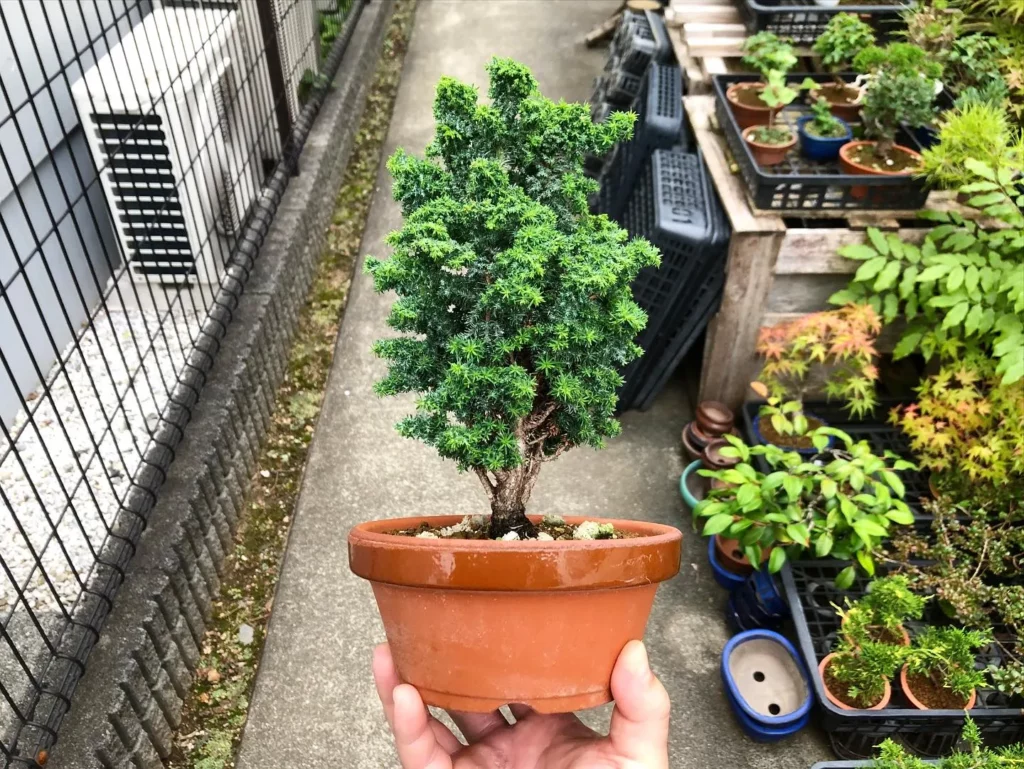
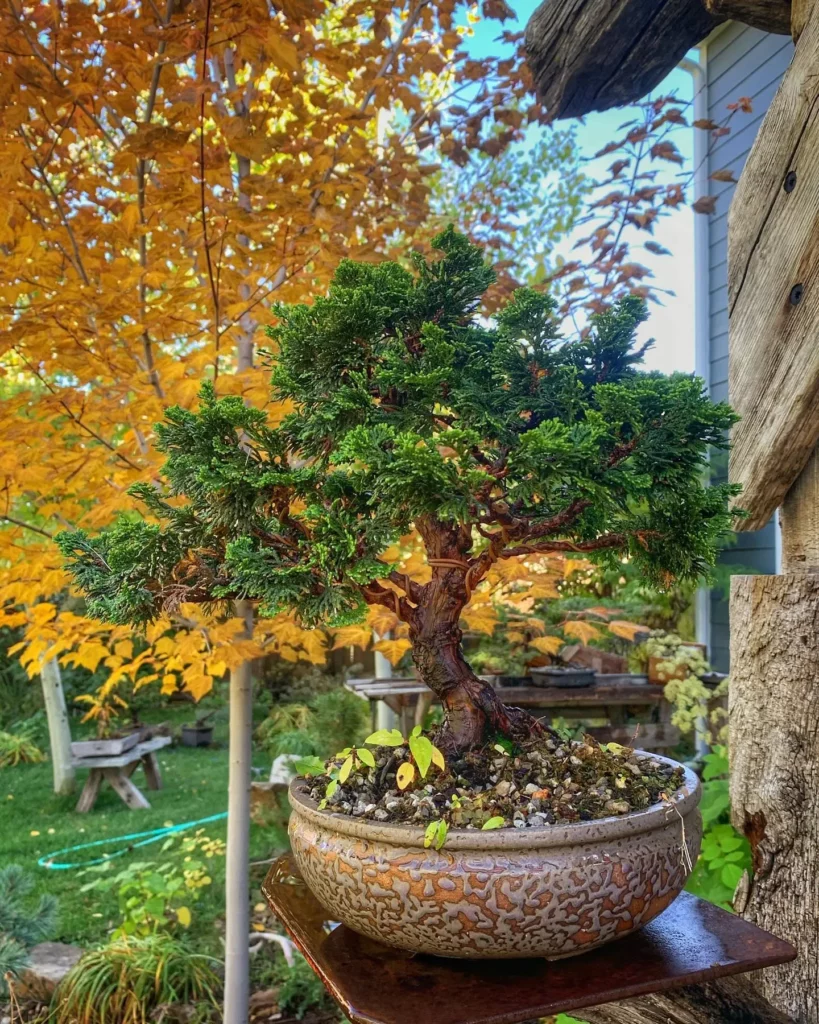
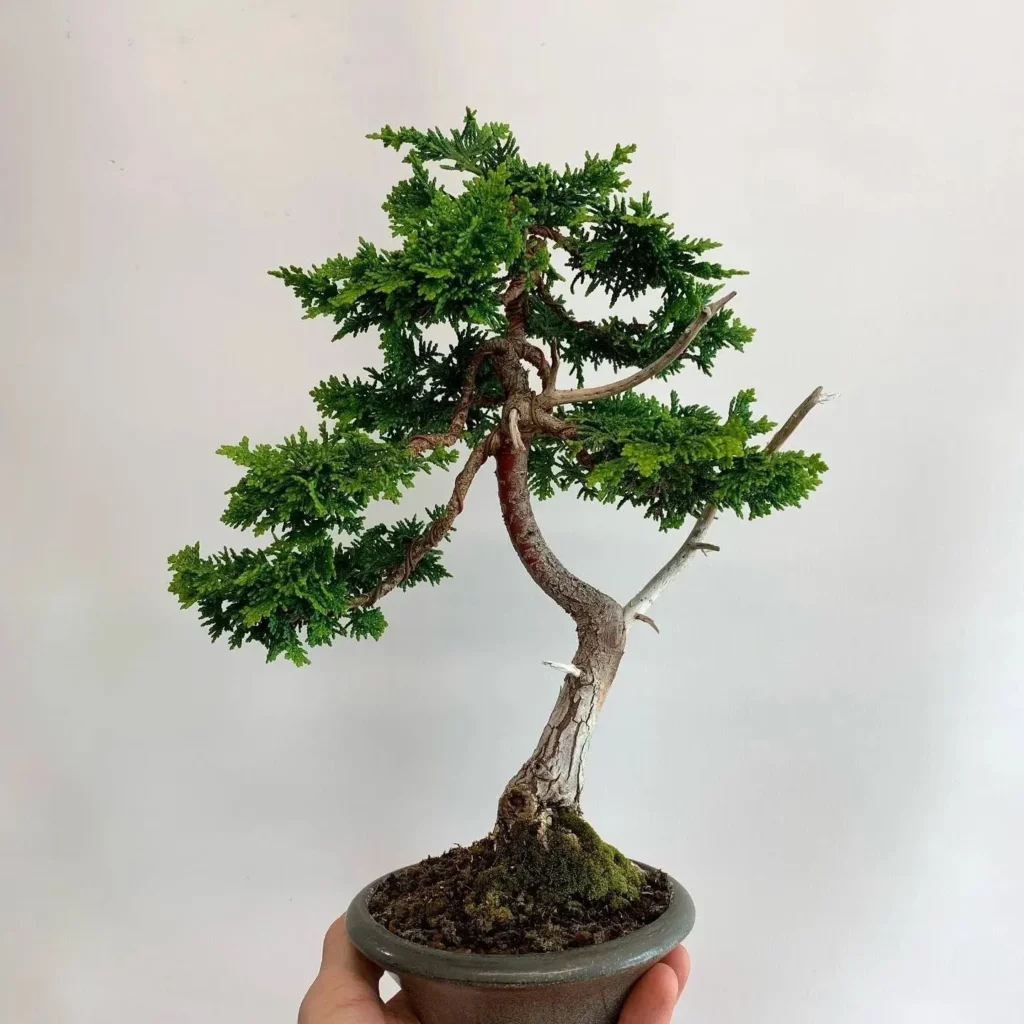
Proper fertilizing plays a crucial role in the health and growth of your Hinoki Cypress Bonsai. Here are some essential tips to ensure you provide the right nutrients to your bonsai tree:
- Frequency: Fertilize your Hinoki Cypress Bonsai every four weeks during the growing season. This regular feeding schedule will supply the necessary nutrients for its development.
- Fertilizer options: You have two primary options for fertilizers – solid organic fertilizer or liquid fertilizer. Choose one that suits your preference and follow the product instructions for the correct application.
- Application: When applying the fertilizer, make sure to distribute it evenly across the soil surface. Avoid overfertilizing, as it can lead to nutrient burn and harm the tree. Always follow the recommended dosage.
- Watering after fertilizing: After applying the fertilizer, water your bonsai thoroughly. This will help to prevent salt buildup and ensure that the nutrients are properly absorbed by the roots.
Potting the Hinoki Cypress Bonsai
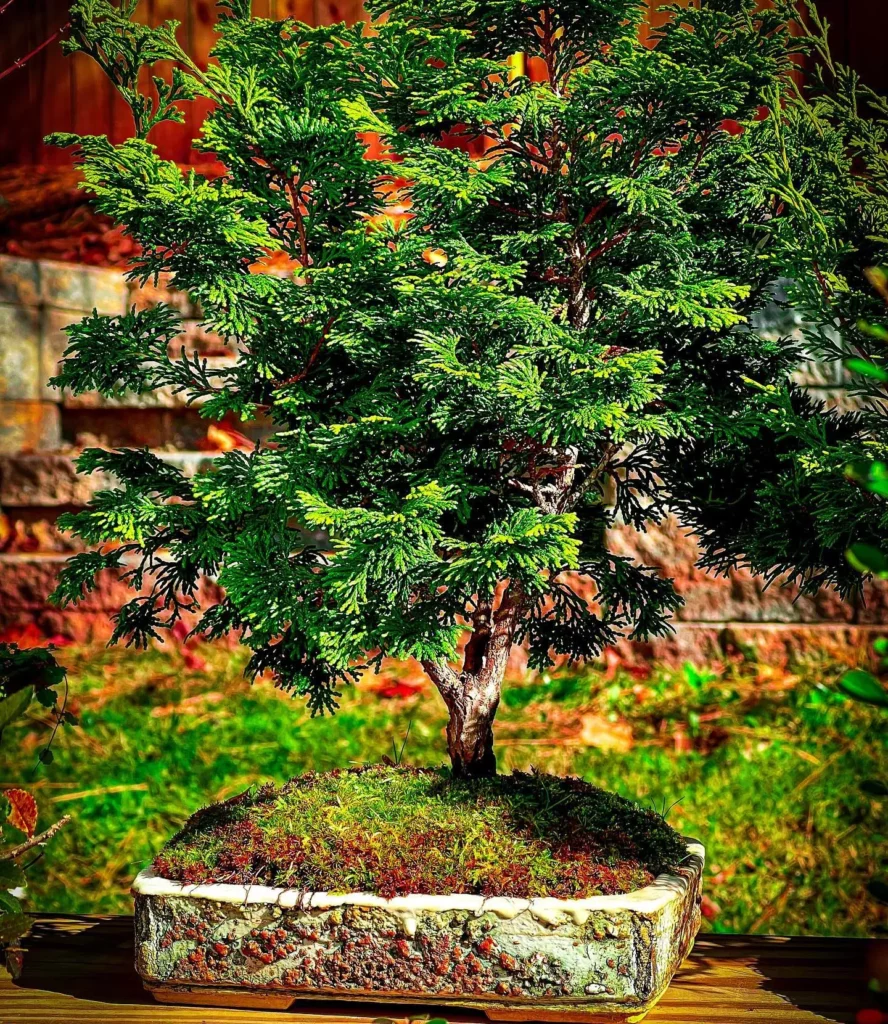
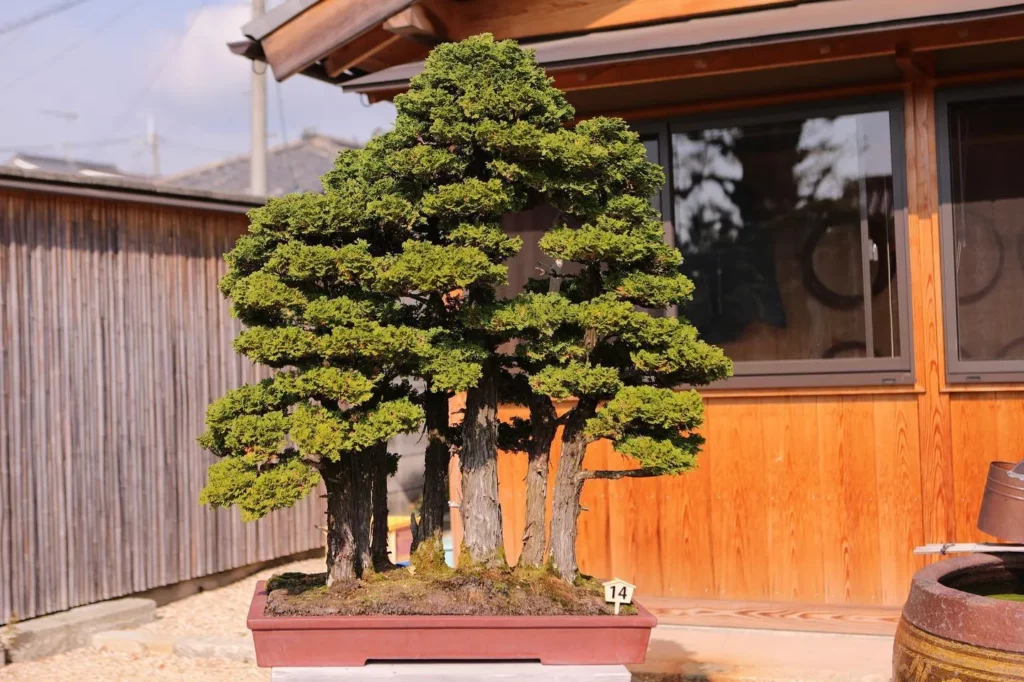
Potting is an essential aspect of caring for your Hinoki Cypress Bonsai. Repotting should be done every two to four years, using a well-draining soil mix that allows proper airflow to the roots. When repotting, it is important to prune the roots significantly to encourage new growth and prevent root-bound issues. Use sharp bonsai shears to carefully trim away any thick or tangled roots.
Choose a pot that is slightly larger than the current one, allowing enough room for the roots to spread and grow. The pot should have drainage holes to prevent waterlogged soil. Place a layer of mesh or fine wire over the drainage holes to keep the soil from escaping.
Prepare the soil mix by combining high-quality bonsai soil, such as akadama, with other components like pumice and lava rock. This mixture provides a well-draining environment for the bonsai. Fill the pot with the soil mix, leaving enough space for the root ball.
Repotting Steps:
- Remove the bonsai from its current pot by gently tapping the sides and bottom. If necessary, use a root hook to tease the root ball out of the pot.
- Inspect the roots for any signs of damage or rot. Trim away any dead or unhealthy roots using sterile bonsai shears.
- Position the bonsai in the new pot, making sure it sits slightly off-center to create a dynamic composition. Place the root ball on top of the soil mixture.
- Add more soil mix around the roots, gently pressing it down to eliminate air pockets. Take care not to bury the trunk too deeply.
- Water the bonsai thoroughly to settle the soil. Keep the tree in a shaded area for a few weeks to allow the roots to recover.
Propagation of the Hinoki Cypress Bonsai
The propagation of the Hinoki Cypress Bonsai can be done through different methods, allowing you to expand your bonsai collection and share the beauty of this tree with others. Here are three common propagation techniques:
Taking Seeds
Seeds are one of the ways to propagate the Hinoki Cypress Bonsai. Collect mature cones from the mother tree, and allow them to dry naturally. To break seed dormancy, you can cold-stratify the seeds by storing them in the refrigerator for several weeks. Sow the seeds in a well-draining soil mix and provide adequate moisture. Keep in mind that seed propagation can be a slow process, as it can take up to a year for the seeds to germinate.
Softwood Cuttings
Softwood cuttings are another effective method to propagate the Hinoki Cypress Bonsai. Take cuttings from healthy branches during late summer when the wood is soft and flexible. Remove the lower leaves and dip the cut end in rooting hormone. Plant the cuttings in a suitable soil mix and provide them with consistent moisture and indirect light. With proper care, the cuttings will develop roots and grow into new bonsai trees.
Air-Layering
Air-layering is a technique that allows you to create new bonsai trees without cutting or removing branches from the mother tree. Select a healthy branch, and make a small incision to expose the inner wood. Apply rooting hormone to the wounded area and cover it with moist sphagnum moss. Wrap the moss with plastic film and secure it in place. Over time, roots will form in the moss layer. Once the roots are well-developed, you can carefully remove the new plant from the mother tree and pot it separately.
- Propagation of the Hinoki Cypress Bonsai can be achieved through seed, softwood cuttings, and air-layering.
- Seeds require a cold pre-treatment and can take up to a year to germinate.
- Softwood cuttings should be taken during late summer and require rooting hormone for successful propagation.
- Air-layering allows you to create new bonsai trees without cutting branches and can be done by wrapping a moss layer around a chosen branch.
Growth and Development of the Hinoki Cypress Bonsai
Proper care and maintenance are crucial for the growth and development of your Hinoki Cypress Bonsai. To promote healthy growth, regular pruning is necessary. This helps remove excess and overlapping shoots, allowing the bonsai to maintain its desired shape and health. Regular pruning also encourages new growth and enhances the overall aesthetic of the bonsai.
Another essential factor for the growth and development of your Hinoki Cypress Bonsai is providing adequate sunlight. Ensure that your bonsai receives sufficient sunlight, as the inner leaves may die if they don’t get enough light. Place your bonsai in a location where it can avail maximum sunlight, but be cautious in hot climates, as some shade may be necessary to protect the tree from intense sun exposure.
Apart from pruning and sunlight, rewiring the branches of your Hinoki Cypress Bonsai may be required multiple times to maintain their desired positions. This helps in creating a well-balanced and aesthetically pleasing bonsai. Styling can be done throughout the year, depending on the growth patterns and the desired shape you wish to achieve.
Tips for Growth and Development of the Hinoki Cypress Bonsai:
- Regularly prune the bonsai to remove excess and overlapping shoots.
- Ensure that your bonsai receives sufficient sunlight, but protect it from intense sun exposure in hot climates.
- Rewire the branches as needed to maintain their desired positions.
- Experiment with styling to create a well-balanced and aesthetically pleasing bonsai.
Pests and Diseases of the Hinoki Cypress Bonsai
The Hinoki Cypress Bonsai, like any other plant, is susceptible to certain pests and diseases. It is important to be aware of these potential issues so that you can take proactive measures to prevent and manage them effectively. Here are some common pests and diseases that can affect your Hinoki Cypress Bonsai:
Pests:
- Scale: These tiny insects can latch onto the leaves and branches of your bonsai and suck out the sap, causing damage and stunted growth. If you notice scale infestation, you can use specific pesticides that are safe for bonsais to eliminate the pests.
- Spider Mites: These microscopic pests can spin fine webs on your bonsai and feed on the plant’s juices, leading to discoloration and weakening of the foliage. Regularly inspect your bonsai for signs of spider mite activity and use appropriate treatments to control their population.
Diseases:
- Tip Blight: This fungal disease can cause browning and dieback of the tips of the branches. It is important to promptly remove and destroy any infected parts of the bonsai and use a fungicide specifically formulated to treat tip blight.
Conclusion
Remember to provide your Hinoki Cypress Bonsai with the right amount of light throughout the year. Place it in a location where it can receive full sun during the growing season, but consider providing some shade in hot climates to protect it from intense sun exposure.
Proper watering is crucial for the health of your bonsai. Keep the soil moist but avoid overwatering, and use lime-free water to prevent any damage to the tree. During winter, water less frequently but ensure the rootball doesn’t dry out completely.
Regular fertilizing, pruning, and repotting are essential for maintaining the shape and health of your Hinoki Cypress Bonsai. Fertilize every four weeks using organic or liquid fertilizer, prune to remove excess growth, and repot every two to four years using well-draining soil mix. Additionally, be vigilant in protecting your bonsai from pests and diseases, such as scale, spider mites, and tip blight.
With proper care and dedication, you can create a thriving and beautiful Hinoki Cypress Bonsai. Enjoy the rewards of your efforts as you watch your bonsai tree flourish and bring a touch of nature’s beauty into your home or garden.
FAQ
How much sunlight does the Hinoki Cypress Bonsai require?
The Hinoki Cypress Bonsai needs full sun during the growing season and adequate light in winter. It is important to place the bonsai where it can receive maximum sunlight to promote healthy growth. However, in hot climates, some shade may be necessary to protect the tree from intense sun exposure.
How often should I water the Hinoki Cypress Bonsai?
The Hinoki Cypress Bonsai should be watered as soon as the soil becomes dry, but it should not be kept soaking wet all the time. It is important to use lime-free water for watering. During winter, the bonsai should be watered less frequently, but the rootball should never be allowed to dry out completely. The foliage of the Hinoki Cypress Bonsai appreciates humidity and can suffer when exposed to hot, dry winds.
How often should I fertilize the Hinoki Cypress Bonsai?
To ensure the health and vigor of the Hinoki Cypress Bonsai, it is recommended to fertilize it every four weeks during the growing season. This can be done using either solid organic fertilizer or a liquid fertilizer. Fertilizing provides the necessary nutrients for the bonsai’s growth and development.
How often should I repot the Hinoki Cypress Bonsai?
The Hinoki Cypress Bonsai should be repotted every two to four years, although older specimens can wait longer. When repotting, it is important to prune the roots significantly. A well-draining soil mix should be used, with a slightly acidic pH level. In hot climates, adding more humus to the soil mix can help with water retention.
How can I propagate the Hinoki Cypress Bonsai?
The Hinoki Cypress Bonsai can be propagated through various methods, including seed, softwood cuttings, and air-layering. Seeds require a cold pre-treatment and can take up to a year to germinate. Softwood cuttings are best taken in late summer. Air-layering can also be successful in propagating this bonsai species.
How should I prune and style the Hinoki Cypress Bonsai?
The growth and development of the Hinoki Cypress Bonsai can be promoted through regular pruning to remove excess and overlapping shoots. Adequate sunlight is crucial for the bonsai to thrive, as the inner leaves may die if they do not receive sufficient sunlight. The branches of the Hinoki Cypress Bonsai may require rewiring several times to maintain their desired positions. Styling can be done throughout the year.
What pests and diseases should I be aware of for the Hinoki Cypress Bonsai?
The Hinoki Cypress Bonsai may be prone to infestations by pests such as scale and spider mites. In such cases, specific pesticides should be used. Additionally, the bonsai may be susceptible to tip blight, which requires a special fungicide for treatment. Proper care and regular inspection can help prevent and manage pests and diseases.
How do I care for the Hinoki Cypress Bonsai to ensure healthy growth?
The Hinoki Cypress Bonsai requires diligent care and maintenance to ensure healthy growth and development. With proper attention to light requirements, watering, fertilizing, pruning, and protection against pests and diseases, bonsai enthusiasts can cultivate thriving Hinoki Cypress Bonsai trees. By following the guidelines provided in this care and maintenance guide, you can embark on a successful green journey with your Hinoki Cypress Bonsai today.




